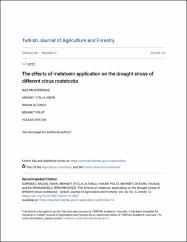The effects of melatonin application on the drought stress of different citrus rootstocks

Göster/
Tarih
2022Yazar
Korkmaz, NazanAşkın, Mehmet Atilla
Altunlu, Hakan
Polat, Mehmet
Okatan, Volkan
Kahramanoğlu, İbrahim
Üst veri
Tüm öğe kaydını gösterKünye
KORKMAZ, NAZAN; AŞKIN, MEHMET ATİLLA; ALTUNLU, HAKAN; POLAT, MEHMET; OKATAN, VOLKAN; and KAHRAMANOĞLU, İBRAHİM (2022) "The effects of melatonin application on the drought stress of different citrus rootstocks," Turkish Journal of Agriculture and Forestry: Vol. 46: No. 4, Article 14. https://doi.org/10.55730/1300-011X.3027Özet
Drought is among the most crucial limiting factors for crop production and is considered a major threat to food security. Rootstock selection is an important approach for drought management. This research was aimed to study the responses of important rootstocks against drought stress and to examine the impacts of melatonin application on the drought stress of these rootstocks. Carrizo citrange, fying dragon, and sour orange were selected for the current study. To test the drought stress, three different irrigation regimes were applicated separately to each rootstock as 100%, 75%, and 50% of water requirement. The melatonin was then tested on each rootstock*irrigation plot with four different doses (0.5 mM, 1.0 mM, 1.5 mM, and 2 mM) and an untreated control application. Results suggested that melatonin application significantly increases the root and shoot growth of the test rootstocks. Besides that, the highest root length was noted from a Flying dragon, while the Carrizo citrange had the highest shoot height. As a response to the drought stress, the leaf membrane permeability of rootstocks increased and the relative water contents decreased. Both traits were noted to be improved by the melatonin application. In terms of the leaf relative water content and membrane permeability, the Flying dragon rootstock was observed to be more tolerant to drought as compared with the Carrizo citrange and sour orange. External melatonin application was also observed to reduce the proline content in the leaves under drought stress, which is a sign of improvement of the crop’s tolerance to drought.

















